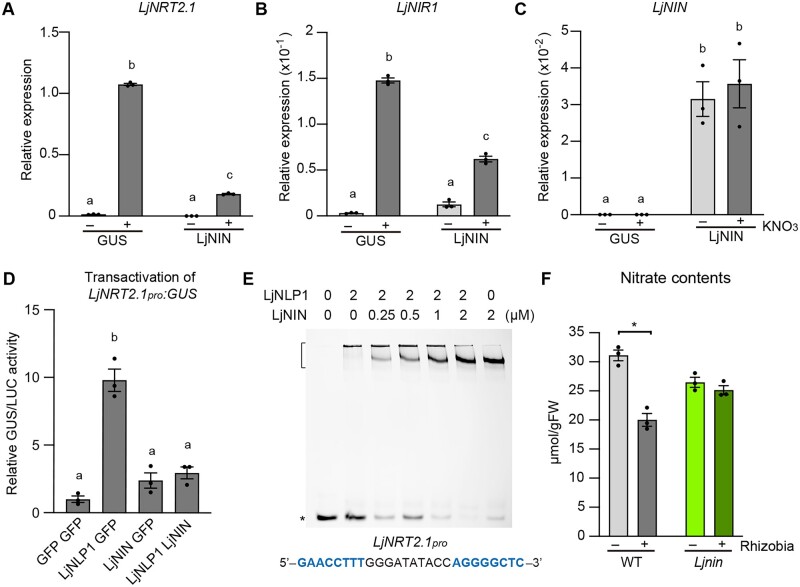Figure 10.
The regulation of LjNRT2.1 expression by LjNIN. A–C, RT-qPCR analysis of LjNRT2.1 (A), LjNIR1 (B), and LjNIN (C) expression in WT transgenic hairy roots transformed with the LjUBQpro:GUS or LjUBQpro:LjNIN constructs. Each cDNA sample was prepared from total RNA derived from noninoculated roots pretreated with 0 (−) or 10 mM KNO3 (+) for 24 h (n = 3 independent pools of roots derived from 10 plants). Transgenic roots were identified by GFP fluorescence. The expression of LjUBQ was used as the reference. Error bars indicate sem. Different letters indicate statistically significant differences (P < 0.05, one-way ANOVA followed by multiple comparisons). D, Transactivation of LjNRT2.1pro:GUS in L. japonicus mesophyll protoplasts transformed with three respective constructs (n = 3 independent pools of protoplasts). Transformed protoplasts were incubated with 10 mM KNO3. GUS activity was measured relative to 35Spro:LUC activity. Transactivation data are normalized using the condition in which GFP is expressed. Different letters indicate statistically significant differences (P < 0.05, one-way ANOVA followed by multiple comparisons). E, EMSA showing LjNLP1 or LjNIN binding to the cis-elements on the LjNRT2.1pro. MBP-LjNLP1 (573‒903) or MBP-LjNIN (551–878) recombinant proteins, consisting of an RWP-RK and a PB1 domain, were incubated with the FAM-labeled DNA probe (Figure 5A; Supplemental Data Set 1). Concentration of the proteins is shown. Bracket and asterisk, respectively, indicate the position of shifted bands showing protein–DNA interaction and of free probes that did not interact with proteins. F, Nitrate contents in inoculated (7 dai) (+) and noninoculated (−) roots of the WT and Ljnin-9 mutants (n = 3 independent pools of roots derived from four plants). The plants were first grown in each condition without KNO3, incubated with 10 mM KNO3 for 24 h, followed by measurement of the root nitrate contents. Error bars indicate sem. *P < 0.05 by a two-sided Welch’s t test.

